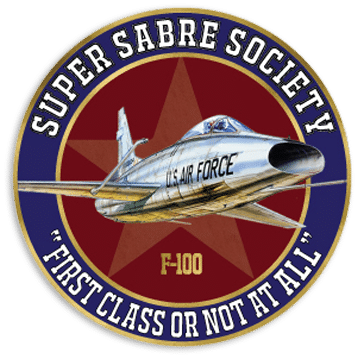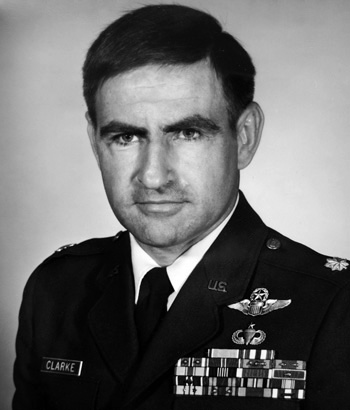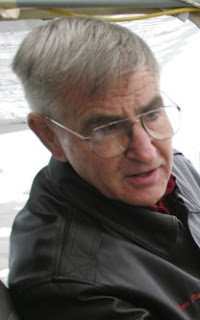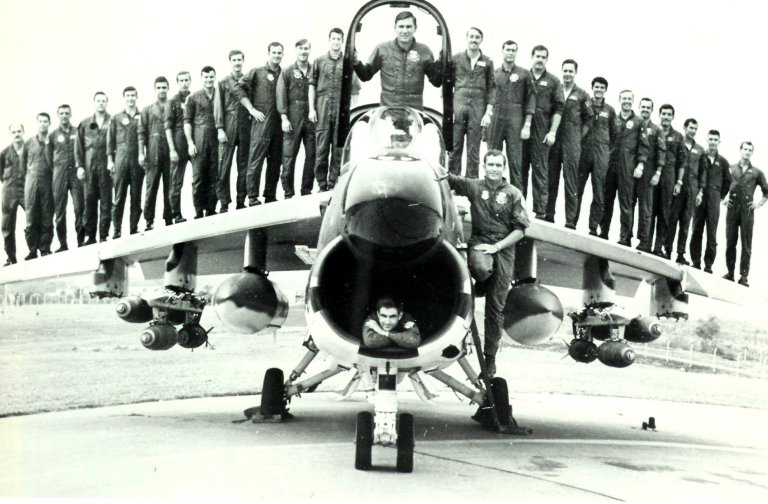Arnie Clarke “enlisted in the U.S. Naval Reserve on January 3, 1954, and was trained as an Electronics Technician. Clarke completed his bachelor’s degree in Marketing from the University of Washington in 1958, and received an honorable discharge from the Naval Reserve on May 3, 1960, in order to attend Air Force Officer Training School. He was commissioned a 2d Lt in the U.S. Air Force at Lackland AFB, Texas, on August 9, 1960, and completed Undergraduate Pilot Training and was awarded his pilot wings at Williams AFB, Arizona, in September 1961.
Lt Clarke next completed F-100 Super Sabre Combat Crew Training and then served with the 522nd Tactical Fighter Squadron (TFS) at Cannon AFB, New Mexico, from October 1962 to May 1965. During this time, he deployed to Southeast Asia in support of the Vietnam War two times, first from December 1962 to February 1963, and then again from August 1964 to February 1965, flying 27 combat missions in the process.
Capt Clarke then transferred to the 77th TFS at RAF Wethersfield, England, where he served until July 1968, when he again deployed to Southeast Asia. He flew 285 combat missions with the 352nd TFS at Phan Rang AB and later from Phu Cat AB in the Republic of Vietnam between July 1968 and July 1969, flying the F-100, O-1 Bird Dog, OV-10 Bronco, OH-6 Cayuse, and one mission in a Navy F-4J Phantom II flying off the USS Ranger (CV-61). During this time, Clarke volunteered as a Misty FAST FAC from January to July 1969.
After returning from Vietnam, Maj Clarke served as an Air Liaison Officer with the U.S. Army’s 82nd Airborne Division at Fort Bragg, North Carolina, from August 1969 to May 1971. He then completed A-7 Corsair II Combat Crew Training and served with the 356th TFS of the 354th TFW at Myrtle Beach AFB, South Carolina, from May 1971 to March 1974. During this time, he deployed to Southeast Asia as an A-7 Sandy pilot, where he flew an additional 73 combat missions from Korat Royal Thai AFB, Thailand, between October 1972 and March 1973.
During his 385 combat missions in Southeast Asia, Clarke was shot down and rescued twice, first on August 18, 1964, and a second time while flying as a Misty FAC on January 22, 1969. His next assignment was as an Air Force Advisor to the 185th Tactical Fighter Group of the Iowa Air National Guard from March 1974 to July 1978, and then as Chief of the Joint Operations Branch, Air Force Operations and Training Division, of the Military Assistance Advisory Group in Tehran, Iran, from July 1978 to February 1979, when he was evacuated due to the Iranian Revolution.
Col Clarke’s final assignment was as Chief of Current Operations with Headquarters 17th Air Force at Sembach AB, West Germany, from February 1979 until his retirement from the Air Force on August 1, 1981.
After his retirement from the Air Force, Arnie managed Pangborn Memorial Airport in East Wenatchee, Washington” (1) until January 1, 2004, “and was working on building a Glastar on amphibian floats. In September ’05, he flew 66.5 hours to commemorate Canada’s first Atlantic crossing. He also visited major aviation museums in Canada and flew in the Toronto airshow. Go to www.airic.ca and Classic Aircraft to see photos over Toronto.”(2)
“His Air Force Cross Citation reads:
The President of the United States of America, authorized by Section 8742, Title 10, United States Code, awards the Air Force Cross to Major Colin A. Clarke for extraordinary heroism in military operations against an opposing armed force as On-Scene Commander for search and rescue operations over North Vietnam on 18 November 1972. On that date, Major Clarke directed an extremely complex mission that resulted in the successful recovery of two downed airmen despite adverse weather, mountainous terrain, and intense hostile ground fire. Disregarding these hazards, his own safety, and battle damage to his aircraft, he personally guided the rescue helicopter to the survivors’ location, suppressed hostile defenses, and continued to direct rescue efforts even though he sustained additional damage to his aircraft. Through his extraordinary heroism, superb airmanship, and aggressiveness in the face of the enemy, Major Clarke reflected the highest credit upon himself and the United States Air Force
Arnie Clarke died on December 13, 2010, and was buried at Tahoma National Cemetery in Kent, Washington” (1)
(1) Source: VeteranTributes.com
(2) MistyVietnam.com
Colin “Arnie” Clarke, LtCol USAF, Ret., “Headed West” on December 13, 2010. Here is a tribute by his friend, Mike Paradise.
Here is a tribute to my good friend, Arnie Clarke. We flew together many times and all my Intake cover photos (3) were taken by him. Vietnam gunners could not get him but he was shot down by cancer in 2010. He had two ejections and received the Air Force Cross for the “Longest Mission” famous rescue of two Thud drivers. He would have received the Medal of Honor but for his naughty flyover after the mission. The “Sandy” rescue A-7D 970 is in the AF Museum along with his story.”
Arnie’s Obituary from The Wenatchee World…
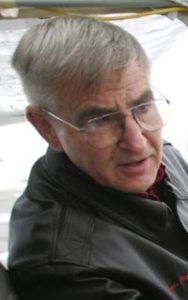 “Colin “Arnie” Clarke died on December 13, 2010, under the loving care of his family and a wonderful Hospice team. He was born in Seattle in 1935 and spent early school years in Federal Way and Bothell. He graduated from the University of Washington in 1958, with a degree in Business. Later, Arnie obtained two Master’s degrees in Business. He joined the Navy Reserves in his college years, but eventually transferred to the Air Force to fly jet fighters and served four tours in Vietnam, eventually retiring as a Lt. Col.
“Colin “Arnie” Clarke died on December 13, 2010, under the loving care of his family and a wonderful Hospice team. He was born in Seattle in 1935 and spent early school years in Federal Way and Bothell. He graduated from the University of Washington in 1958, with a degree in Business. Later, Arnie obtained two Master’s degrees in Business. He joined the Navy Reserves in his college years, but eventually transferred to the Air Force to fly jet fighters and served four tours in Vietnam, eventually retiring as a Lt. Col.
He served as the Pangborn Airport Manager from 1982 until 2003. Arnie was committed to many service projects with Rotary, where he served as President and was a Paul Harris Fellow. The Miss Veedol project was important to him and he served as Chief Pilot and Chairman, taking part in the National Air Tour and in the Canadian Historical Society tour to commemorate Canada’s first flight across the Atlantic. Flying was also a very important part of his life and he served as President of the Experimental Aircraft Association in Wenatchee, and was a 29-year supporter and also a President of the Soaring Club.
A favorite project was serving as the principal pilot for William Layman, as they photographed the T.A. Weaver Rephotographic Project for the Wenatchee Valley Museum in his home-built Glasair, for the Atlas Narrative of the Columbia River. This was an aerial photo-mapping project to show the changes in the entire length of the Columbia River in the last 50 years.
He loved woodworking and built a house on Lake Wenatchee and remodeled several homes, but his last and perhaps favorite project (other than the airplane) was a three-story tree-house for his grandchildren. He was a lifetime runner, following in the path of several generations of family runners. The most memorable race was a 100k race in Switzerland, which he ran when he was 46, and the important thing for him was that he finished. He was an avid photographer. He spent several years building an airplane, which he loved to fly, and in which he loved to give rides to friends.
He is survived by his wife of 53 years, Sandra Blain Clarke; daughters, Andriette Clarke Timblin and Alison (Kevin) Jenne; 12 grandchildren; and one great-grandson. He was preceded in death by son, Arnold. Also surviving are three siblings, Bill Clarke, Larry Clarke and Molly Clarke Kenzler; and greatly loved are sister-in-law, Martha and husband, Ralph Lieser, who were at his beck and call during his final illness.
Arnie lived a full life, always challenging those around him to see the best in others and to reach for the best in themselves. We have been blessed by his life.
A Mass of Christian Burial will take place in Wenatchee at St. Joseph’s Catholic Church was held on Monday, December 20, 2010, and is buried in Tahoma National Cemetery in Kent, Washington. To remember Arnie, in lieu of flowers you can contribute to St. Joseph’s Catholic School; Wellness Place; or our local VFW, P.O. Box 7115, East Wenatchee, WA 98802, to be used for Veteran’s relief.
During his 385 combat missions in Southeast Asia, Clarke was shot down and rescued twice, first on August 18, 1964, and a second time while flying as a Misty FAC on January 22, 1969.
18 Aug 64: First F-100 loss in SEA. 1/Lt C. A. Clarke ejected from F-100D 56-3085 hit by Pathet Lao AAA over Laos while supporting a downed T-28 crew. Rescued by Air America helicopter in Thailand.
22 Jan 69: Second ejection for Arnie Clarke. He was Misty FAC 89 on a MISTY 51 mission with Misty FAC 88 John Grathwol when the J57 engine lost oil pressure and they were not able to make it to DaNang. Both safely ejected from F-100F 56 3886 and were quickly rescued by Jolly Green helo.
